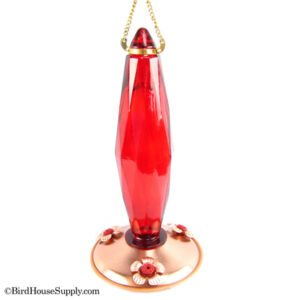Step into a gardening store or browse a bird watching website and you’re likely to see thousands of choices for Hummingbird feeders. There are many types to choose from. Choosing the best feeder for your yard or porch is all about knowing what feeder style will suit the birds in your area.
Two Main Hummingbird Feeder Styles
Most Hummingbird feeders fall into one of two styles, saucer feeders or inverted feeders. Each type of feeders has pros and cons. Understanding how they are different will help you determine which will work best for you.
Saucer Feeders
Saucer Feeders are just what they sound like; a small saucer-like dish is filled with a nectar solution. The dish usually has ports above the reservoir which allows the hummingbird to dip its bill into the liquid nectar. These feeders won’t stay full for long, but are easy to refill and clean. Additionally, a saucer feeder is not as visible to the Hummingbird so may attract fewer birds.
Inverted Feeders
 Inverted feeders have a central retainer that is suspended over the feeding spots and automatically releases the nectar from the top. This ensures that all ports are filled to optimum levels at all times. The inverted style makes it easy to check nectar levels and these feeders typically have a much higher capacity to store nectar than saucer-style feeders. However, because the reservoir hangs over the feeder, they are more likely to leak and require careful cleaning.
Inverted feeders have a central retainer that is suspended over the feeding spots and automatically releases the nectar from the top. This ensures that all ports are filled to optimum levels at all times. The inverted style makes it easy to check nectar levels and these feeders typically have a much higher capacity to store nectar than saucer-style feeders. However, because the reservoir hangs over the feeder, they are more likely to leak and require careful cleaning.
Choosing the right Hummingbird Feeder
Once you’ve decided on which type of feeder you prefer, consider these factors when picking out a feeder for your yard:
- What the feeder is made of: Feeders are constructed with many different materials. Glass, plastic and metal feeders are all commonly used. Think about what fits your needs and budget best. Plastic feeders will discolor over time and need to be replaced. Glass feeders can break more easily, but will not fade or warp. Metal feeders may cause nectar to ferment more quickly, but are less prone to breakage. All three types have benefits and draw backs. Choose which works best for you.
- Color: There is a reason that most Hummingbird feeders are red. Hummingbirds prefer red and yellow to all other colors.
- How many birds your feeder will attract: The more capacity your feeder has, generally the more birds you will attract. Keep in mind that large feeders are a bad idea for yards with few birds. The nectar is likely to ferment before it is all used. Think about whether you want an occasional bird to view or large amounts taking over the porch. Additionally, the number of feeding ports will need to be larger for larger flocks of birds. Otherwise, the Hummingbird’s natural competitiveness will take over.
- Mounting: Think about where you will be placing your feeder. Most are designed to be mounted on poles or hung on a branch or porch. Which type fits your needs best?
- Insect Guards: Hummingbirds will visit your feeder primarily in summer. That means you may want a feeder with a bee or ant guard to protect the birds from insects.
Hummingbirds are not picky birds and are always hungry (after all, they have tiny bellies). Understanding which options fit your home best will help you enjoy these popular birds on sunny days all summer long.

